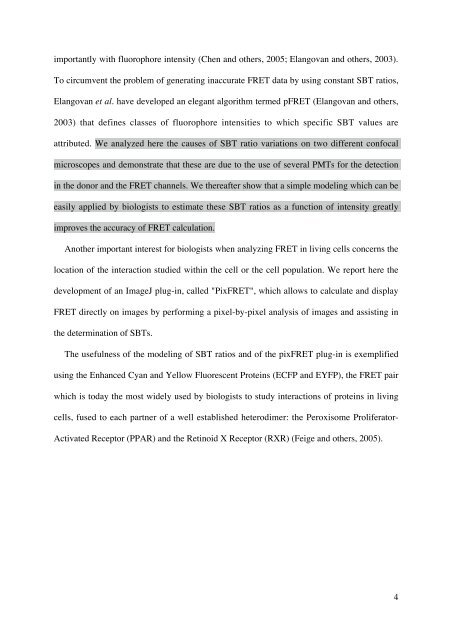PixFRET, an ImageJ plug-in for FRET calculation which can ...
PixFRET, an ImageJ plug-in for FRET calculation which can ...
PixFRET, an ImageJ plug-in for FRET calculation which can ...
- No tags were found...
You also want an ePaper? Increase the reach of your titles
YUMPU automatically turns print PDFs into web optimized ePapers that Google loves.
import<strong>an</strong>tly with fluorophore <strong>in</strong>tensity (Chen <strong>an</strong>d others, 2005; El<strong>an</strong>gov<strong>an</strong> <strong>an</strong>d others, 2003).To circumvent the problem of generat<strong>in</strong>g <strong>in</strong>accurate <strong>FRET</strong> data by us<strong>in</strong>g const<strong>an</strong>t SBT ratios,El<strong>an</strong>gov<strong>an</strong> et al. have developed <strong>an</strong> eleg<strong>an</strong>t algorithm termed p<strong>FRET</strong> (El<strong>an</strong>gov<strong>an</strong> <strong>an</strong>d others,2003) that def<strong>in</strong>es classes of fluorophore <strong>in</strong>tensities to <strong>which</strong> specific SBT values areattributed. We <strong>an</strong>alyzed here the causes of SBT ratio variations on two different confocalmicroscopes <strong>an</strong>d demonstrate that these are due to the use of several PMTs <strong>for</strong> the detection<strong>in</strong> the donor <strong>an</strong>d the <strong>FRET</strong> ch<strong>an</strong>nels. We thereafter show that a simple model<strong>in</strong>g <strong>which</strong> c<strong>an</strong> beeasily applied by biologists to estimate these SBT ratios as a function of <strong>in</strong>tensity greatlyimproves the accuracy of <strong>FRET</strong> <strong>calculation</strong>.Another import<strong>an</strong>t <strong>in</strong>terest <strong>for</strong> biologists when <strong>an</strong>alyz<strong>in</strong>g <strong>FRET</strong> <strong>in</strong> liv<strong>in</strong>g cells concerns thelocation of the <strong>in</strong>teraction studied with<strong>in</strong> the cell or the cell population. We report here thedevelopment of <strong>an</strong> <strong>ImageJ</strong> <strong>plug</strong>-<strong>in</strong>, called "<strong>Pix<strong>FRET</strong></strong>", <strong>which</strong> allows to calculate <strong>an</strong>d display<strong>FRET</strong> directly on images by per<strong>for</strong>m<strong>in</strong>g a pixel-by-pixel <strong>an</strong>alysis of images <strong>an</strong>d assist<strong>in</strong>g <strong>in</strong>the determ<strong>in</strong>ation of SBTs.The usefulness of the model<strong>in</strong>g of SBT ratios <strong>an</strong>d of the pix<strong>FRET</strong> <strong>plug</strong>-<strong>in</strong> is exemplifiedus<strong>in</strong>g the Enh<strong>an</strong>ced Cy<strong>an</strong> <strong>an</strong>d Yellow Fluorescent Prote<strong>in</strong>s (ECFP <strong>an</strong>d EYFP), the <strong>FRET</strong> pair<strong>which</strong> is today the most widely used by biologists to study <strong>in</strong>teractions of prote<strong>in</strong>s <strong>in</strong> liv<strong>in</strong>gcells, fused to each partner of a well established heterodimer: the Peroxisome Proliferator-Activated Receptor (PPAR) <strong>an</strong>d the Ret<strong>in</strong>oid X Receptor (RXR) (Feige <strong>an</strong>d others, 2005).4
















